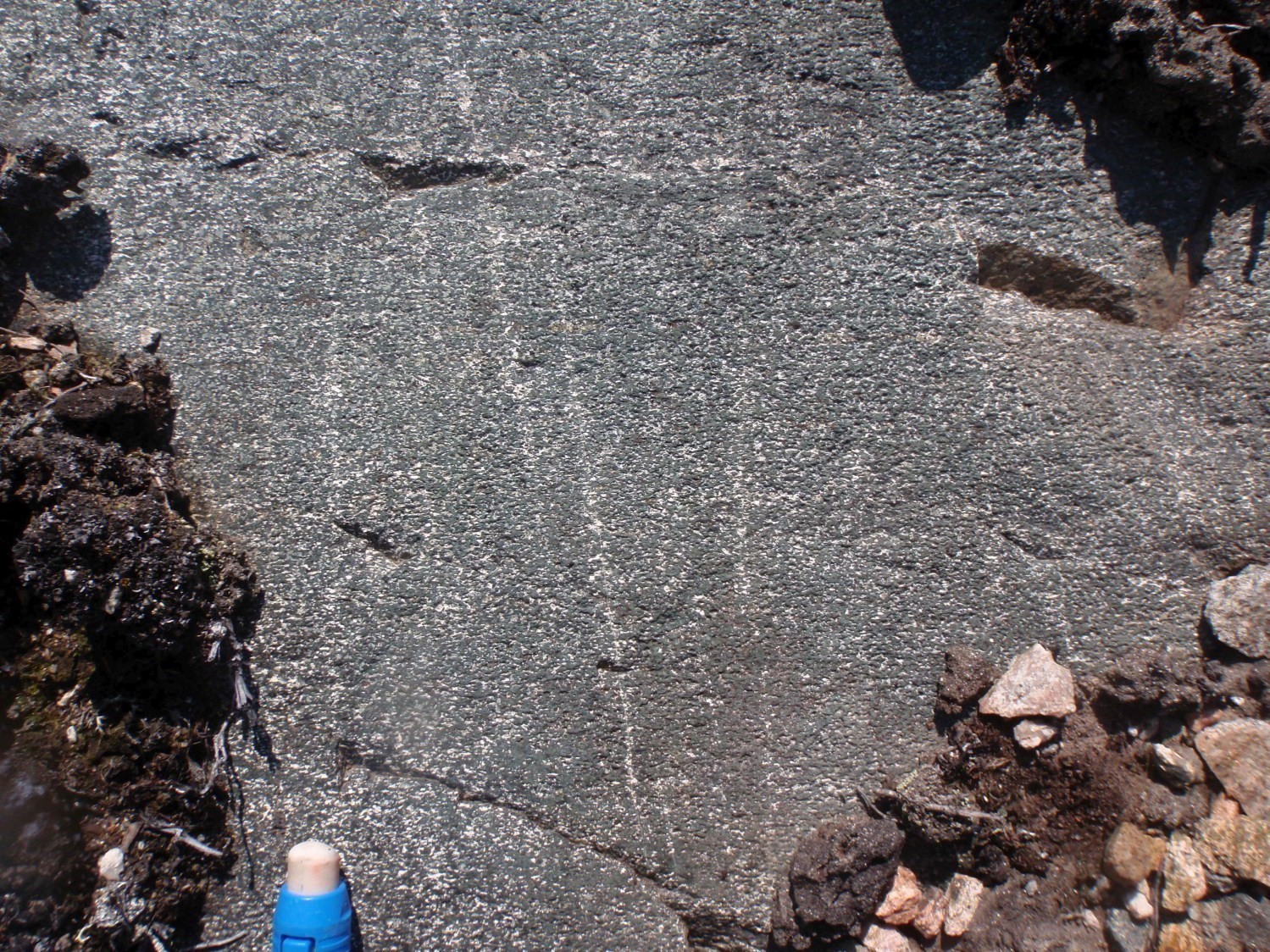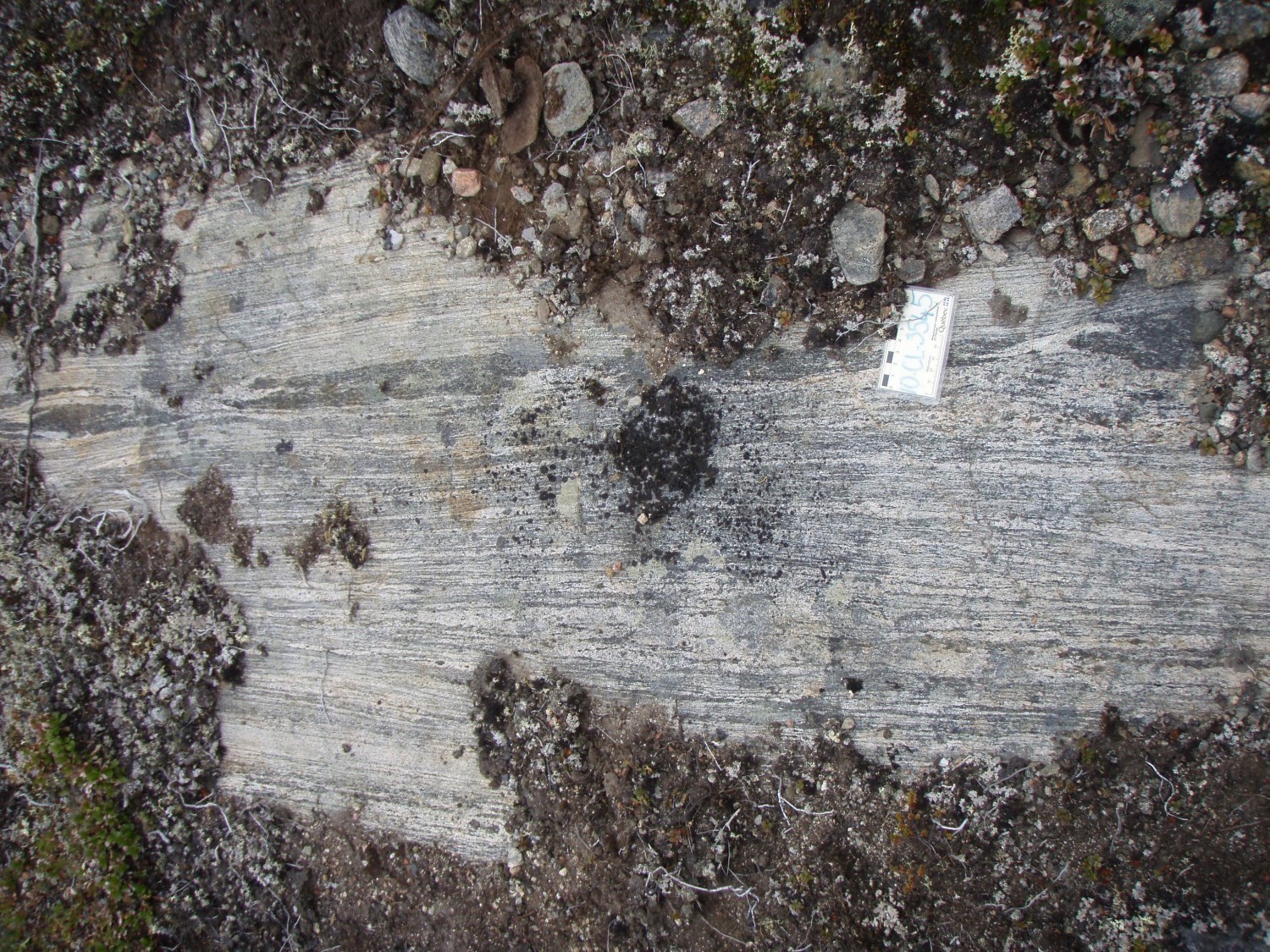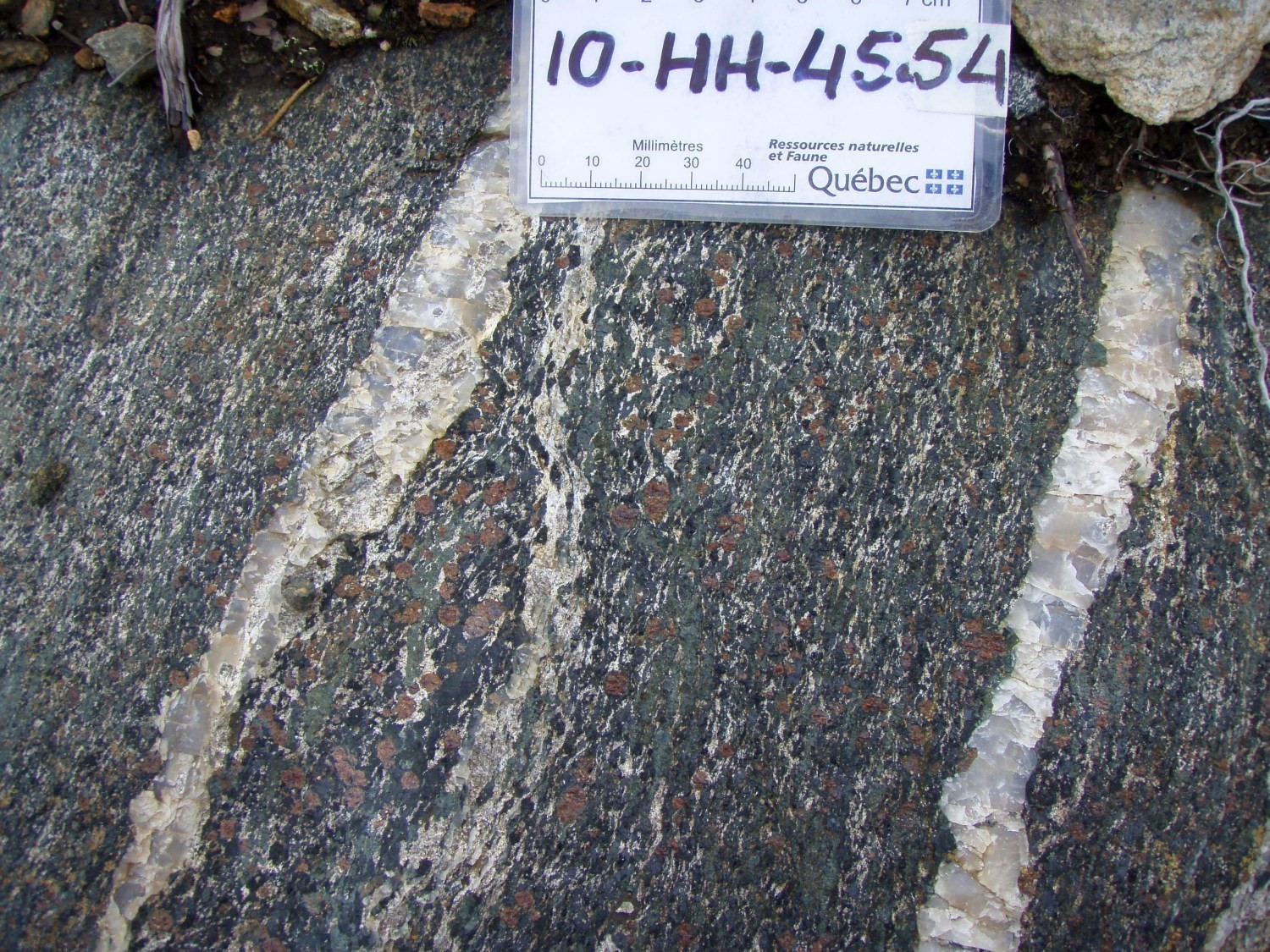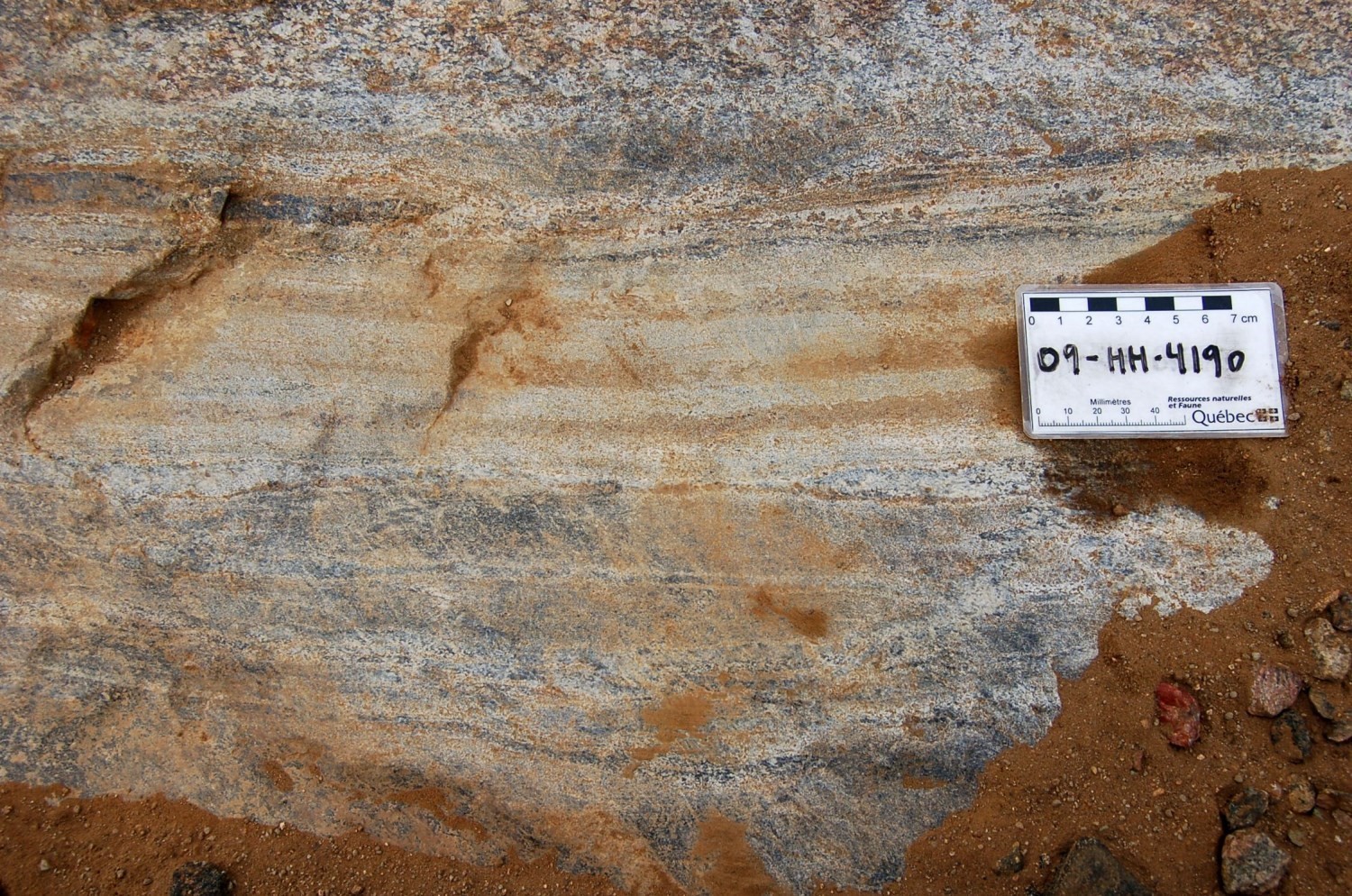
| Author: | Taner, 1987; Hammouche et al., 2011 |
| Age: | Archean to Paleoproterozoic |
| Stratotype: | None |
| Type area: | Juillet Lake area (NTS sheet 23I16) |
| Geological province: | Churchill Province |
| Geological subdivision: | Mistinibi-Raude Lithotectonic Domain |
| Lithology: | Amphibolite, mylonite and paragneiss |
| Category: | Lithodemic |
| Rank: | Complex |
| Status: | Formal |
| Use: | Active |
None
Background
The term “Lac Zeni Volcano-Sedimentary Complex” was introduced by Taner (1987) to describe a supracrustal rock sequence located in the Juillet Lake area. This unit was subsequently extended northward in the Raude Lake area (Danis, 1991). Taner (1987, 1992) initially divided the complex into four units consisting mainly of hornblende-biotite gneiss and garnet amphibolites associated with small amounts of felsic metatuffs, mafic to intermediate metatuffs and gabbroic layers. However, the work of Clark et al. (2008) and Hammouche et al. (2011, 2012) did not confirm the presence of volcanic felsic rocks in this complex. Instead, these authors interpret metatuff layers as heavily deformed granitoids. Given the presence of intrusive rocks and orthogneiss, Hammouche et al. (2011) renamed this unit “Zeni Complex”. The unit name is from Zeni Lake located in sheet 23I16.
Description
The Zeni Complex is associated with a strong positive aeromagnetic anomaly that distinguishes it from adjacent units. It was divided into three informal units by Hammouche et al. (2011, 2012): 1) amphibolite (ApPzen1); 2) felsic and intermediate mylonites (ApPzen2); and 3) paragneiss (ApPzen3). Zeni Complex units are affected by large dextral-moving regional shear zones, such as the Zeni Shear Zone (ZCzen). Deformation is locally intense, giving the rocks a mylonitic appearance with the development of lenticular forms, boudinage structures and silica alteration. Protomylonitic textures were observed at several locations.
Zeni Complex 1 (ApPzen1): Amphibolite
Unit ApPzen1 consists mainly of amphibolite derived from mafic and intermediate intrusive rocks and mafic volcanics. In places, mylonitic rocks similar to those of unit ApPzen2 cut amphibolite or form layers in it. Unit ApPzen1 also contains sparse layers of deformed migmatized paragneiss and little or not deformed late intrusions of various composition.
Amphibolite is generally dark green and locally light green. It is fine grained or, locally, very fine or medium grained. It is granoblastic, massive, foliated or mylonitized and exhibits millimetric banding well visible in altered surface. In places, banding defined by alternating centimetric medium-grained and fine-grained bands is recognized. Amphibolite contains 2 mm to 3 mm thick quartz veinlets and hornblende porphyroblasts. There is also highly recrystallized coarse-grained amphibolite. Unit ApPzen1 amphibolites are mainly composed of amphibole (60-70%, mainly hornblende associated with some actinolite-tremolite) and plagioclase (15-30%). It also contains garnet (2-3%), clinopyroxene, quartz (<5%), biotite and hypersthene. Garnet occurs as millimetric reddish brown crystals, locally in coarser spherical clusters (>1 cm), and can reach 15% locally. Amphibolites contain 1-2% disseminated magnetite and some sphene and apatite. There is also evidence of late hydrothermal alteration characterized by: 1) sericitization and local epidotization; 2) the regular development of chlorite at the expense of biotite and amphibole; 3) the presence of some talc and the replacement of clinopyroxene by amphibole; and 4) the presence of calcite, chlorite and quartz clusters and veinlets (0.5 mm).
Amphibolite is closely associated with metamorphosed gabbroic rocks that are distinguished by a coarser grain size and a more massive and homogeneous overall appearance. These rocks, which range in composition from metagabbro to metagabbronorite, are composed of plagioclase, hornblende, biotite, clinopyroxene, orthopyroxene, garnet and magnetite. The unit also includes late intrusive rocks (ultramafic rock, diorite, tonalite and granite) that are homogeneous, with little or no deformation and that occur in clusters of various sizes. Relationships between these intrusions and the main facies of the unit (amphibolite and felsic mylonite) were not observed. Stratiform layers of metagabbro up to 10 m wide contain centimetric beds rich in magnetite and ilmenite characterized by high Fe, Ti and V contents.
Mylonite layers observed in amphibolite sequences are tonalitic, granitic and quartz dioritic. They are fine to medium grained and usually leucocratic. Mylonitization is expressed by strong flattening of minerals, particularly quartz, which forms millimetric bands. Rocks contain hornblende (5%) and biotite, with some augite (<1%), garnet, magnetite and hypersthene locally. Small amounts (<1%) of sphene and apatite are present. Rocks are minimally altered and contain small amounts of sericite, chlorite and epidote. Locally, late calcite veinlets are present.
Metre to decametre-thick layers of migmatized paragneiss are concentrated north of the ZCzen. The rock is fine grained, brownish, rusty in altered surface and does not exhibit banding. It is composed of plagioclase and quartz (70%), biotite (10%) and granoblastic garnet, fractured and disaggregated (3-5%). There are some feldspar porphyroblasts rimmed by biotite. The rock locally contains orthopyroxene, cordierite, and prismatic sillimanite forming needles. Leucosome is quartzofeldspathic and represents between 5% and 10% of the rock. It occurs as boudinaged bands of irregular thickness ranging from 0.5 cm to 10 cm.
Zeni Complex 2 (ApPzen2): Felsic and Intermediate Mylonites
Felsic and intermediate mylonites of unit ApPzen2 alternate with decimetric to metric, rarely decametric, amphibolite layers giving the sequence a coarsely banded to gneissic appearance. The unit also contains tonalitic to granitic gneiss, locally quartz monzodioritic. The mylonite composition ranges from tonalitic to granitic and from dioritic to quartz monzonitic. Rocks are mainly leucocratic, fine and medium grained. They contain biotite, garnet and magnetite. Hornblende is locally present in minor amounts (2-3%), but can exceptionally be as high as 15%. Augite and hypersthene are locally present. In thin sections, allanite crystals replaced at margins by epidote, as well as apatite and zircon are observed. Quartz banding and mineral alignment define the mylonitic texture. Silicate minerals are anhedral and display a mosaic texture. Biotite occurs in fusiform aggregates of flakes filling interstices between crystals and moulding rounded garnet porphyroblasts. Chlorite, sericite and epidote replace primary minerals.
Amphibolite of unit ApPzen2 is comparable to that of unit ApPzen1, but is coarser grained, has higher recrystallization and a generally larger proportion of garnet. Taner (1992) noted that garnet was an important and characteristic constituent of Zeni Complex mafic rocks. The distribution of garnet is highly variable and random, with abundance ranging from traces up to 30%. Taner (1992) states that garnet occurs as poikilitic crystals when the amount of hornblende (replacing clinopyroxene) is significant. It can also form millimetric rims consisting of garnet in the centre surrounded by plagioclase laths and a large amount of hornblende. Amphibolite is also cut by veinlets composed of plagioclase, amphibole, garnet and quartz porphyroclasts that show significant alteration in chlorite, sericite and epidote.
Gneiss observed in unit ApPzen2 is banded and fine to medium grained. Banding is defined by alternating millimetric leucocratic tonalitic or granitic bands and dark bands consisting primarily of biotite. Gneiss also contains coarser-grained granitic bands (<5%) 1 cm to 2 cm thick and parallel to foliation. Light millimetric bands contain quartz with undulatory extinction, plagioclase, orthose, microcline, and some hornblende and biotite. Dark bands contain biotite ± hornblende with, in places, clinopyroxene, hypersthene (<2%) and magnetite. Apatite, sphene, calcite and zircon are accessory phases. Rocks have a granoblastic or mosaic texture. There are also perthites and myrmekites. The low content in chlorite, epidote and sericite indicates weak alteration.
Mylonites, amphibolites and gneiss of unit ApPzen2 are commonly cut by late and little deformed metric to decametric intrusions of mainly intermediate composition (diorite, monzonite, quartz monzodiorite, quartz diorite and monzodiorite), and by gabbro. Massive and homogeneous intermediate rocks are fine to medium grained and slightly granoblastic. They contain biotite (5-15%), hornblende (5-20%), magnetite (≤3%), some epidote and garnet. Gabbro is distinguished from amphibolite by less important recrystallization and a green and white spotted appearance associated with the presence of plagioclase and amphiboles.
Zeni Complex 3 (ApPzen3): Paragneiss
Unit ApPzen3 consists of highly foliated light to medium grey paragneiss. The rock does not exhibit clear banding, although light minerals appear to be roughly aligned along foliation. Paragneiss is fine grained, homogeneous and mostly composed of quartz (65-80%) with lower amounts of plagioclase (5-15%). It also contains biotite (<10%), muscovite, amphibole and, in places, clinopyroxene, garnet and spinel. Garnet is porphyroblastic and locally forms fractured globular clusters or rims around plagioclase. Spinel was observed in small amounts as rims around other minerals where it is associated with an inner quartz rim. Ferriferous epidote, sericite and, more sparsely, carbonate are present as alteration minerals. Decametric amphibolite layers, also containing augite and garnet, are inserted in paragneiss. Contact with paragneiss is marked by centimetric beds of whitish chert.
Zeni Complex 3a (ApPzen3a): Biotite-Muscovite Schist
Subunit ApPzen3a schist is fine to medium grained. It is grey in fresh exposure and reddish brown in patina. Slaty cleavage parallel to stratification results in the rock breaking into beds less than 10 cm thick (Danis, 1991). Schist consists primarily of muscovite-biotite ± garnet ± sillimanite, and hectometric interstratifications of graphite-muscovite ± garnet ± tourmaline schists. It contains quartz lenses <2 cm long. Owen (1989) also mentions the local presence of andalusite and tourmaline. Subunit ApPzen3a locally contains white muscovite-tourmaline ± garnet ± biotite granitoid layers and lenses <5 m wide (van der Leeden, 1995). Accessory minerals are garnet, tourmaline, zircon, epidote and opaque minerals. Tourmaline tends to form aggregates.
Zeni Complex 3b (ApPzen3b): Paragneiss With Sulphide-Bearing Layers
Surface-oxidized sulphide layers outcrop on two hills aligned along an NNW orientation (Hammouche et al., 2011). These iron formation layers are interstratified in the paragneiss sequence and occur as decametric bands in a zone having a total thickness of 50 m to 60 m over at least 700 m in length that appear to extend southward. They are locally cut into steps by NE-oriented sinistral strike-slip fault cut by late pegmatite veins 10 cm to 12 cm thick.
Thickness and distribution
The Zeni Complex is located in the southern part of the Mistinibi-Raude Lithotectonic Domain (Lafrance et al., 2019). It is 5-15 km wide and extends over 65 km long in a direction varying from N-S to WNW-ESE from north to south. Unit ApPzen1 (271 km2) forms a strip 5 km wide on average, while unit ApPzen2 (616 km2) is 7 km to 10 km wide. Unit ApPzen3 (63 km2) is very narrow (<100 m), ~3 km long and is located in the northern part of the Zeni Complex. Subunits ApPzen3a (7 km2) and ApPzen3b (<1 km2) cover limited areas.
Dating
Dating of a tonalitic mylonite of unit ApPzen2, sampled by Clark et al. (2008), yielded a crystallization age around 2480 Ma, which is considered to be the intrusion age of tonalite in volcano-sedimentary rocks, which places the complex at the boundary between Archean and Paleoproterozoic. The lower intersection of the discordia around 1790 Ma is interpreted as representing a Pb loss associated with a metamorphic event.
| Isotopic System | Mineral | Crystallization Age (Ma) | (+) | (-) | Reference(s) |
| U-Pb | Zircon | 2480 | 11 | 11 | David et al., 2009 |
Stratigraphic Relationship(s)
Structural continuity and lithological similarities between unit ApPzen2 and Advance Complex (ApPadv) units could indicate a relationship. In fact, Taner (1992) states that facies of the Zeni Complex are locally similar to dioritic gneiss of subunit E1e (now assigned to the Advance Complex) characterized by garnet-poor mafic layers.
Unit ApPzen1 unit is limited to the west and east by shear zones. Unit ApPzen2 is therefore in fault contact with unit ApPzen1. The southern contact between the Zeni Complex and the Jannière Complex (ApPjai) and La Pinaudière Granite (nAlai) is also tectonic in nature. A protomylonitic texture with significant local hematitization is developing on both sides of shear zones.
The Zeni Complex is cut by the Ramusio Granite (mPram), which contains enclaves of the Zeni Complex (Taner, 1992).
Paleontology
Does not apply.
References
| Author(s) | Title | Year of Publication | Hyperlink (EXAMINE or Other) |
|---|---|---|---|
| CLARK, T. – LECLAIR, A. – PUFAHL, P. – DAVID, J. | Recherche géologique et métallogénique dans les régions de Schefferville (23J15) et du lac Zeni (23I16). Ministère des Ressources naturelles et de la Faune, Québec; RP 2008-01, 17 pages. | 2008 | RP 2008-01 |
| DANIS, D. | Géologie de la région du lac Raude, Territoire-du-Nouveau-Québec. Ministère de l’Énergie et des Ressources, Québec; ET 88-10, 73 pages, 5 plans. | 1991 | |
| DAVID, J. – MOUKHSIL, A. – CLARK, T. – HEBERT, C. – NANTEL, S. – DION, C. – SAPPIN, A.-A. | Datations U-Pb effectuées dans les provinces de Grenville et de Churchill en 2006-2007. Ministère des Ressources naturelles et de la Faune, Québec; RP 2009-03, 32 pages. | 2009 | RP 2009-03 |
| HAMMOUCHE, H. – LEGOUIX, C. – GOUTIER, J. – DION, C. – PETRELLA, L. | Géologie de la région du lac Bonaventure. Ministère des Ressources naturelles, Québec; RG 2011-03, 37 pages, 1 plan. | 2011 | RG 2011-03 |
| HAMMOUCHE, H. – LEGOUIX, C. – GOUTIER, J. – DION, C. | Géologie de la région du lac Zeni. Ministère des Ressources naturelles, Québec; RG 2012-02, 35 pages, 1 plan. | 2012 | RG 2012-02 |
| CHARETTE, B. – LAFRANCE, I. – VANIER, M.-A. – GODET, A. | Domaine de Mistinibi-Raude, sud-est de la Province de Churchill, Nunavik, Québec, Canada : synthèse de la géologie. Ministère de l’Énergie et des Ressources naturelles, Québec. BG 2019-07. | 2019 | BG 2019-07 |
| LAFRANCE, I. – CHARETTE, B. – VANIER, M.-A. | Sud-est de la Province de Churchill, Nunavik, Québec, Canada : synthèse de la géologie. Ministère de l’Énergie et des Ressources naturelles, Québec. | 2019 | Bulletin géologiQUE |
| TANER, M.F. | Reconnaissance géologique de la région du lac Juillet, Territoire-du-Nouveau-Québec. Ministère de l’Énergie et des Ressources, Québec; MB 91-19, 132 pages, 7 plans. | 1992 | MB 91-19 |
| TANER, M.F. | Reconnaissance géologique de la région du lac Juillet, Nouveau-Québec. Ministère de l’Énergie et des Ressources, Québec; DP 87-11, 23 pages, 7 plans. | 1987 | DP 87-11 |
| VAN DER LEEDEN, J. – BÉLANGER, M. – DANIS, D. – GIRARD, R. – MARTELAIN, J. | Lithotectonic domains in the high-grade terrain east of the Labrador Trough (Quebec). In: The Early Proterozoic Trans-Hudson Orogen (Lewry, J.F. and Stauffer, M.R., editors). Geological Association of Canada; Special Paper 37, pages 371-386. | 1990 | – |






